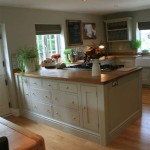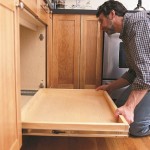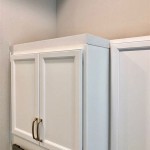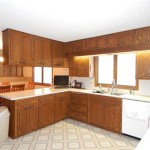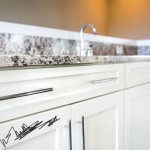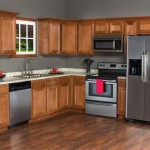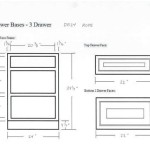Kitchen Cabinets Cost Estimator: Understanding Factors and Budgeting
Kitchen renovations are a significant investment, and kitchen cabinets often represent a substantial portion of the overall budget. Accurately estimating the cost of new kitchen cabinets is crucial for effective financial planning and project management. A "kitchen cabinets cost estimator," whether a tool or a process, seeks to provide a realistic projection of expenses based on various factors. This article outlines the key determinants of kitchen cabinet costs, the types of cabinets available, and how to approach estimating your budget for this essential home improvement.
Key Factors Influencing Kitchen Cabinet Costs
Several factors significantly impact the price range of kitchen cabinets. Understanding these factors will allow for a more refined and accurate cost estimation.
Cabinet Material: The choice of material for cabinet boxes and doors is a primary cost driver. Solid wood cabinets, such as cherry, maple, or oak, are typically the most expensive option due to their durability, aesthetic appeal, and natural variations. Plywood is often used for cabinet boxes as a more cost-effective and stable alternative to solid wood. Medium-density fiberboard (MDF) is another common material for cabinet boxes and doors, especially those with painted finishes, as it provides a smooth, uniform surface. Laminate and thermofoil finishes are applied to MDF or particleboard and are generally the most affordable options. The type of wood, its grade, and the complexity of the finish all contribute to variations in material costs.
Cabinet Construction: The construction method used in building the cabinets also affects their price. Framed cabinets, the traditional style, feature a face frame attached to the front of the cabinet box. This frame adds structural support and provides a surface for attaching doors and drawers. Frameless cabinets, also known as European-style cabinets, do not have a face frame. The doors and drawers attach directly to the cabinet box, resulting in a sleek, modern look with easier access to storage. Frameless cabinets generally require thicker cabinet boxes for structural integrity, which can slightly increase the material cost. Full-overlay doors and drawers, where the door or drawer completely covers the cabinet box, also tend to be more expensive than partial-overlay styles.
Cabinet Type: The type of kitchen cabinets chosen significantly affects the overall price. Stock cabinets are pre-made in standard sizes and styles, making them the most budget-friendly option. Semi-custom cabinets offer a wider range of sizes, styles, and finishes than stock cabinets, allowing for some degree of personalization without incurring the full cost of custom cabinetry. Custom cabinets are built to order, providing complete control over dimensions, materials, style, and features. Custom cabinets are the most expensive option but offer the highest degree of personalization and can maximize space utilization, especially in kitchens with unusual layouts or specific needs. The desired level of customization directly correlates with the cabinet cost.
Cabinet Size and Configuration: The total number of cabinets needed, their size, and their configuration influence the overall cost. Larger kitchens require more cabinets, naturally increasing the total price. Specialized cabinets, such as corner cabinets, pantry cabinets, or cabinets with built-in organizers, typically cost more than standard base or wall cabinets. Similarly, incorporating features like pull-out shelves, soft-close hinges, or integrated lighting adds to the overall expense. The complexity of the kitchen layout and the need for specialized cabinet configurations influence the overall cost.
Hardware and Accessories: The selection of hardware, such as knobs, pulls, hinges, and drawer slides, can also contribute to the final cost. High-end hardware made from premium materials can significantly increase the overall price. Additionally, accessories like spice racks, cutlery dividers, and other organizational inserts add to the cost. While these items may seem relatively inexpensive individually, their cumulative effect can be substantial, especially in larger kitchens with numerous cabinets.
Installation Costs: Installation costs are a significant component of the overall kitchen cabinet budget. Professional installation ensures proper alignment, secure attachment, and functional operation of the cabinets. Installation costs vary depending on the complexity of the project, the number of cabinets being installed, and the geographic location. Factors such as removing existing cabinets, leveling floors, and addressing plumbing or electrical issues can also impact installation costs. Obtaining multiple quotes from qualified installers is crucial to ensure competitive pricing and reliable service. DIY installation can save on labor costs, but it requires significant skill and experience to achieve professional results. Improper installation can lead to structural issues and functional problems down the line, potentially offsetting any initial cost savings.
Types of Kitchen Cabinets and Their Cost Implications
Understanding the different types of kitchen cabinets available is essential for informed budgeting. Each type offers a unique balance of cost, customization options, and lead times.
Stock Cabinets: Stock cabinets are pre-built in standard sizes and styles, making them the most readily available and affordable option. They are typically sold at home improvement stores and online retailers. Stock cabinets offer limited customization options and are generally available in a limited range of finishes and materials. Stock cabinets are suitable for budget-conscious homeowners who need a quick solution and do not require highly personalized designs. The limited size and style options can sometimes restrict design flexibility, particularly in kitchens with non-standard layouts.
Semi-Custom Cabinets: Semi-custom cabinets offer a middle ground between stock and custom cabinetry. They are pre-built but allow for some modifications to size, style, and finish. Semi-custom cabinets provide a wider range of options than stock cabinets, allowing for some degree of personalization without the high cost of custom work. Homeowners can often choose from various door styles, wood species, and paint colors. Semi-custom cabinets are a good option for those who want more design flexibility than stock cabinets offer but are not willing to invest in fully custom cabinetry. The increased customization options come with a slightly higher price tag and longer lead times compared to stock cabinets.
Custom Cabinets: Custom cabinets are built to order, providing complete control over every aspect of the design. They are the most expensive option but offer the greatest degree of personalization and can maximize space utilization in kitchens with unique layouts. Custom cabinet makers can create cabinets in any size, shape, and style, using a wide range of materials and finishes. Custom cabinetry is ideal for homeowners who have specific design requirements or want to create a truly unique kitchen. The design process typically involves working closely with a cabinet maker or designer to create detailed plans and specifications. The lead times for custom cabinets are typically longer than those for stock or semi-custom cabinets, as each cabinet is built from scratch. The higher cost reflects the level of craftsmanship, personalization, and design expertise involved.
RTA (Ready-to-Assemble) Cabinets: RTA cabinets are shipped flat-packed and require assembly by the homeowner or a contractor. They are often a more affordable alternative to pre-assembled cabinets, as they reduce shipping costs and allow for self-assembly. RTA cabinets are available in a range of styles and materials, from basic stock options to more upscale designs. The quality of RTA cabinets can vary widely, so it's important to research brands and read reviews before making a purchase. Assembly can be time-consuming and requires some degree of skill. RTA cabinets are a good option for budget-conscious homeowners who are comfortable with DIY projects and are willing to invest the time and effort required for assembly.
Strategies for Estimating Kitchen Cabinet Costs
Accurately estimating the cost of kitchen cabinets requires a systematic approach. Here are some effective strategies:
Measure the Kitchen Space: Accurate measurements are essential for determining the number and size of cabinets needed. Measure the length and height of walls, the location of windows and doors, and the position of plumbing and electrical fixtures. Create a detailed floor plan that includes all relevant dimensions. This information will be used to determine the number of cabinets required and their placement. Consider the overall layout and desired functionality of the kitchen when planning the cabinet configuration.
Determine Cabinet Types and Quantities: Based on the kitchen layout and desired storage capacity, determine the types and quantities of cabinets needed. Include base cabinets, wall cabinets, pantry cabinets, corner cabinets, and any specialized cabinets. Consider the size and configuration of each cabinet, as well as any desired features such as pull-out shelves or soft-close hinges. Create a detailed list of all the cabinets needed, including their dimensions and any special requirements. This list will serve as a basis for obtaining quotes from suppliers and installers.
Research Cabinet Materials and Styles: Research the various cabinet materials and styles available, and determine which ones align with your budget and aesthetic preferences. Visit showrooms, browse online retailers, and consult with designers to explore the options. Consider the durability, maintenance requirements, and overall appearance of each material and style. Obtain samples of different materials and finishes to evaluate them in your kitchen lighting. This research will help narrow down the choices and provide a basis for comparing prices from different suppliers.
Obtain Multiple Quotes: Obtain quotes from multiple cabinet suppliers and installers. Provide each supplier with the same detailed information, including the kitchen measurements, cabinet types and quantities, and desired materials and styles. Request a breakdown of costs, including the price of the cabinets, delivery fees, and installation charges. Compare the quotes carefully, paying attention to the quality of the cabinets, the experience of the installer, and the overall value offered. Be sure to ask about any hidden costs or potential surcharges. Obtaining multiple quotes ensures competitive pricing and provides a basis for negotiation.
Factor in Additional Costs: Remember to factor in additional costs beyond the price of the cabinets and installation. These costs may include demolition of existing cabinets, plumbing or electrical work, flooring repairs, countertop installation, and backsplash installation. Create a comprehensive budget that includes all potential expenses. Add a contingency fund to cover unexpected costs or unforeseen issues. This will help avoid budget overruns and ensure that the project stays on track.
Utilize Online Cost Estimators: Several online tools and calculators can provide a rough estimate of kitchen cabinet costs. These estimators typically ask for information about the size of the kitchen, the type of cabinets desired, and the geographic location. While these estimators can provide a general idea of the cost range, they should not be relied upon as a substitute for professional quotes. The accuracy of online estimators can vary depending on the data used and the complexity of the project. Use them as a starting point for researching costs and developing a budget.
Consider Phased Installation: If the initial quotes exceed the budget, consider phasing the installation. Install the most essential cabinets first, and complete the remaining installation at a later date. This can help spread out the cost over time and make the project more manageable. Prioritize the cabinets that are most critical for functionality and storage. Phased installation allows for completing the project in stages without compromising the overall design.
By considering these factors and utilizing effective estimation strategies, homeowners can develop a realistic budget for their kitchen cabinet project and make informed decisions about materials, styles, and installation options.

How Much Do Custom Cabinets Cost
Kitchen Remodel Cost Estimator Main Line Design

Kitchen Cabinet Cost Estimator Avoid Errors Save Time

Kitchen Cabinet Cost Estimator Avoid Errors Save Time

Kitchen Remodel Cost Estimator Main Line Design

What Is The Average Kitchen Cabinet Cost

How Much Will Your Kitchen Cabinets Cost Design Partner

Kitchen Cabinet Cost Estimator Avoid Errors Save Time

Kitchen Remodel Cost Estimate Tool Calculator Refresh Inc

How Much Does A Kitchen Remodel Cost 2024 Average
Related Posts

